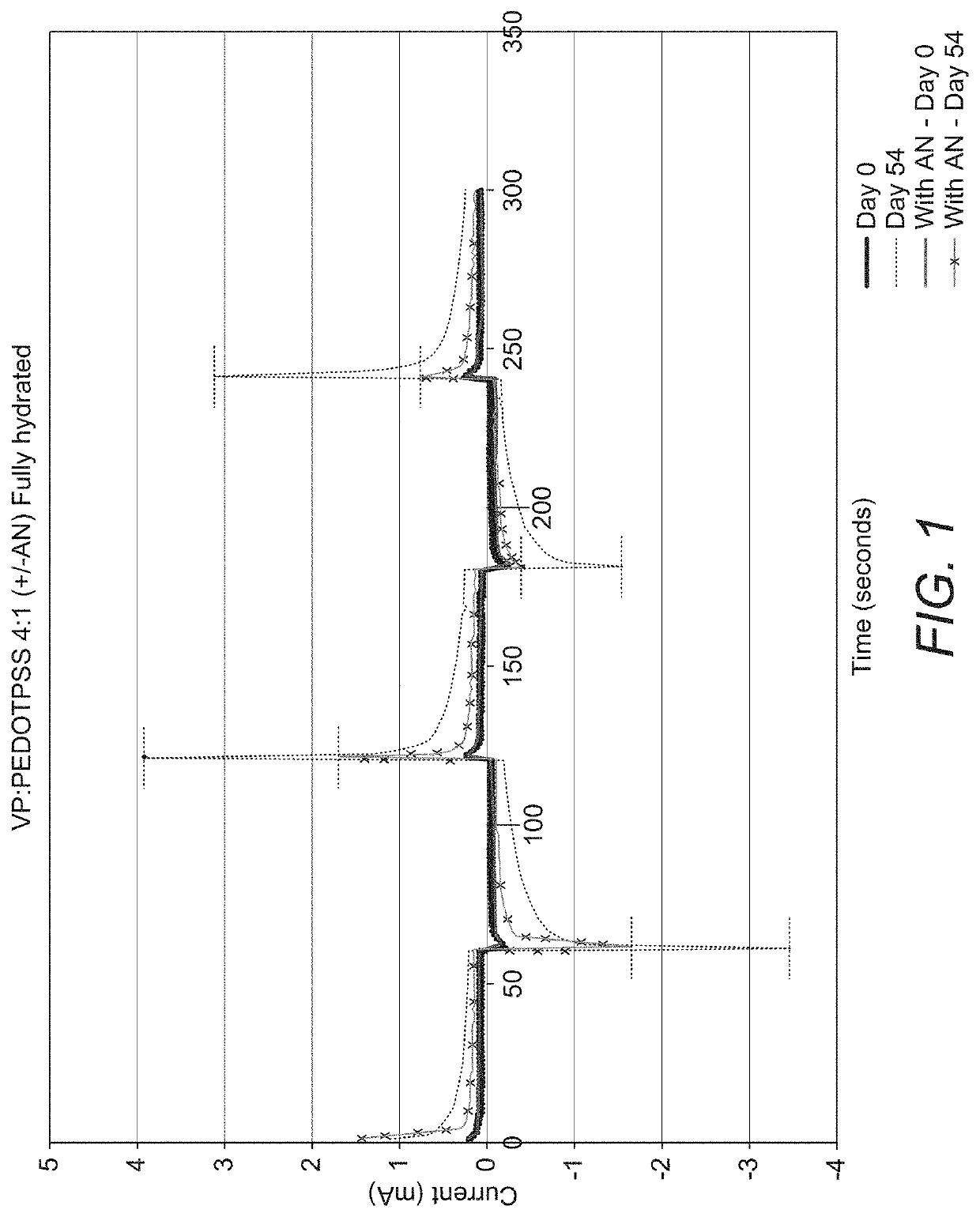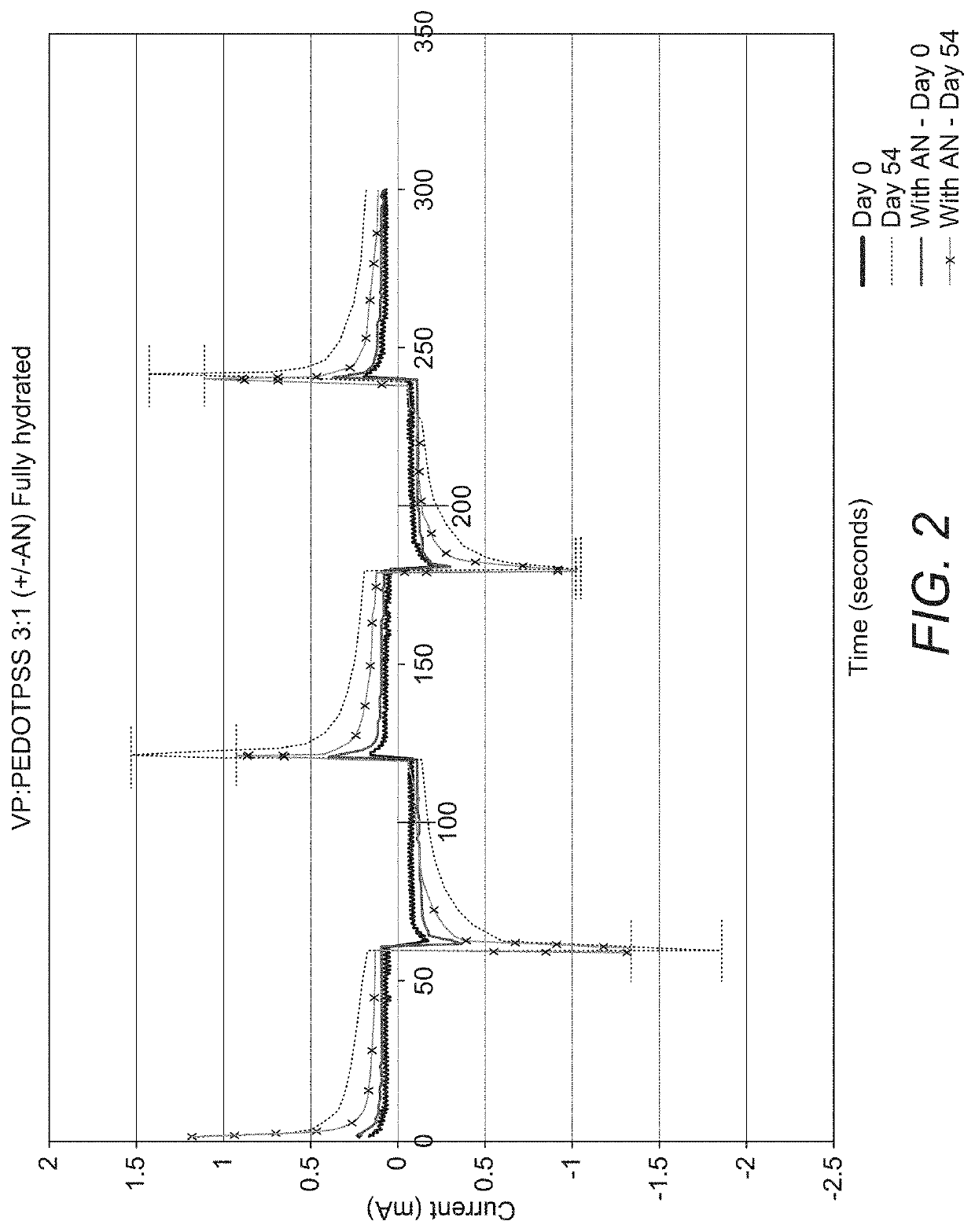Electrically conducting hydrophilic co-polymers
a hydrophilic polymer and electric conductor technology, applied in the direction of non-metal conductors, conductors, fixed capacitor details, etc., to achieve the effects of improving mechanical properties and self-supporting nature, improving electronic properties, and high capacitance values
- Summary
- Abstract
- Description
- Claims
- Application Information
AI Technical Summary
Benefits of technology
Problems solved by technology
Method used
Image
Examples
example 1
PEDOT-PSS
[0083]A first hydrophilic co-polymer was prepared using vinyl pyrollidone and PEDOT-PSS in a 4:1 ratio, together with allyl-methacrylate (as crosslinking agent and hydrophobic co-monomer). In addition, a second hydrophilic co-polymer was prepared using vinyl pyrollidone and PEDOT-PSS in a 4:1 ratio, together with allyl methacrylate (as crosslinking agent) and acrylonitrile (AN) (as hydrophobic co-monomer).
[0084]To obtain a 4:1 ratio of VP to PEDOT-PSS, 1.5 ml of water was added to 1 ml of PEDOT-PSS whilst stirring using a magnetic stirrer bar. 4 ml of 1-vinyl-2-pyrrolidone was then added dropwise to the PEDOT-PSS / water mixture. After a homogenous mixture was obtained, 0.195 ml of allyl methacrylate was added, as was 0.13 ml of 2-hydroxy-2-methylpriophenone (as the initiator). The co-monomer mixture was then cured under UV to produce the first crosslinked co-polymer.
[0085]The above process was repeated with the additional step that 6 weight % of acrylonitrile was added to th...
example 2
PEDOT-PSS
[0089]A first hydrophilic co-polymer was prepared using vinyl pyrollidone and PEDOT-PSS in a 3:1 ratio, together with allyl-methacrylate (as crosslinking agent and hydrophobic co-monomer). In addition, a second hydrophilic co-polymer was prepared using vinyl pyrollidone and PEDOT-PSS in a 3:1 ratio, together with allyl methacrylate (as crosslinking agent) and acrylonitrile (as hydrophobic co-monomer).
[0090]Each of these co-polymers was prepared using the same method as that of Example 1, except that 3 ml (rather than 4 ml) of 1-vinyl-2-pyrollidone was used.
[0091]Each co-polymer was hydrated in DD water, and the conductivity tested immediately after maximum level of hydration was achieved; for the first co-polymer (i.e. no acrylonitrile present) this was when a water content of approximately 61% was reached, and for the second co-polymer (i.e. with acrylonitrile present) this was when a water content of approximately 57% was reached. The electrical properties were then measu...
PUM
| Property | Measurement | Unit |
|---|---|---|
| conductivity | aaaaa | aaaaa |
| electrical conductivities | aaaaa | aaaaa |
| temperatures | aaaaa | aaaaa |
Abstract
Description
Claims
Application Information
 Login to View More
Login to View More - R&D
- Intellectual Property
- Life Sciences
- Materials
- Tech Scout
- Unparalleled Data Quality
- Higher Quality Content
- 60% Fewer Hallucinations
Browse by: Latest US Patents, China's latest patents, Technical Efficacy Thesaurus, Application Domain, Technology Topic, Popular Technical Reports.
© 2025 PatSnap. All rights reserved.Legal|Privacy policy|Modern Slavery Act Transparency Statement|Sitemap|About US| Contact US: help@patsnap.com


